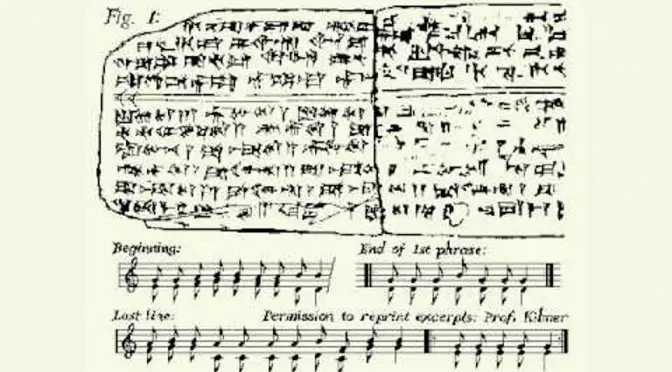Written about 3,400
According to an article published on RichardDawkins.net, several clay tablets from the 14th-century B.C.E which are unearthed by archaeologists in the early 1950s turned out to be the oldest known piece of music ever discovered, a 3,400-years-old Sumerian hymn.
Video: listen to the oldest song ever discovered
The piece confirms a theory that the 7-note diatonic scale, as well as harmony, existed 3,400 years ago.
For fifteen years Prof. Anne Draffkorn Kilmer puzzled over clay tablets relating to music including some excavated in Syria by French archaeologists in the early ’50s. The tablets from the Syrian city of ancient Ugarit (modern Ras Shamra) were about 3400 years old, had markings called cuneiform signs in the Hurrian language (with borrowed Akkadian terms) that provided a form of musical notation.
One of the texts formed a complete cult hymn and is the oldest preserved song with the notation in the world. Finally, in 1972, Kilmer, who is a professor of Assyriology, University of California, and a curator at the Lowie Museum of Anthropology at Berkeley, developed an interpretation of the song based on her study of the notation.
The top parts were the words and the bottom half instructions for playing the music. Kilmer, working with colleagues Richard L. Crocker and Robert R. Brown produced a record and booklet about the song called Sounds From Silence.
The song, it turns out, is in the equivalent of the diatonic “major” (“do, re, mi”) scale. In addition, as Kilmer points out: “We are able to match the number of syllables in the text of the song with the number of notes indicated by the musical notations”.
This approach produces harmonies rather than a melody of single notes. The chances the number of syllables would match the notation numbers without intention are astronomical.
This evidence both the 7-note diatonic scale, as well as harmony, existed 3,400 years ago flies in the face of most musicologists’ views that ancient harmony was virtually non-existent (or even impossible) and the scale only about as old as the Ancient Greeks, 2000 years ago. Said Crocker: “This has revolutionized the whole concept of the origin of western music.”
Find Confirms Theory
The book The Origin of Music by Herbert Spencer and Waldo S. Pratt puts forward the view that there is a natural foundation to the diatonic scale, that it has existed likely even from antiquity. In addition, the book espoused evidence showing that harmony, as well, existed in antiquity.
Thus, the oldest song known from a cuneiform document has provided major confirmation to this viewpoint. In turn, the theory may even now help to interpret the findings. Kilmer wrote: “I certainly do like and am profiting from The Origin of Music”.
Why Do Scales, Keys, and Harmony Exist?
At the earliest times in musical development, a sense of “melody” would not have occurred overnight. Prior to it, music often was the playing of single notes, assigned to various rituals, such as one gong for the moon, another for sun, another for death, birth, etc., and played without much or any regard to their success as a musical melody of any sort. Scales might even be virtually non-existent as was harmony.
What is harmony for? After all, a single tone is more “pure” than any combination of tones or chords, which are cluttered with overtones that are usually dissonant with each other. Why did humanity bother to add, to the relatively clean single tone, “harmony” notes (and therefore, greater dissonance)?
The answer is that harmony’s function has evolved mostly to make the notes of melodies “connect” or to make their connection to each other melodically more apparent to the ear by making their common inner overtones audibly explicit in chords. It follows that harmony had no reason to exist among many people who are lacking scales. Scales are, historically, “congealed” or “generic” melody in the abstract.
Once scales are developed (especially a favored two, major and minor), then we are looking at people for whom connections between notes are very important. The agenda is whether the melody is important enough for them to overlook the dissonant elements in chords (compared to their purer, more consonant single tones), so as to allow them to use chords in the enhancement of their melodies. Only after the full scale and melody develop first can harmony even begin to appear on this historical agenda. The oldest song dates this agenda far earlier in time and gives to the diatonic scale a near-universal status not formerly ascribed to it.
“Tonality”, which is defined as a “loyalty to a keynote”, is also exhibited in the oldest song by repeating phrases found at the end of sentences, usually on the same note as the keynote of the tune.
- Tchaikovsky: Piano Trio [Martha Argerich, Gidon Kremer, Mischa Maisky] - April 25, 2024
- Pavarotti sings Pourquoi me réveiller [Massenet] at the Central Park in 1993 - April 23, 2024
- Elgar: Serenade for Strings [Concertgebouw Chamber Orchestra] - April 19, 2024

